Table of Contents
Introduction
When most of us think of robots, images of Tesla’s Optimus humanoid or Boston Dynamics’ acrobatic Atlas often come to mind. But the truth is, the fascination with building machines that move, think, and even act like humans is far older than Silicon Valley or modern AI.
Robotics has a story that stretches back thousands of years, from mythological bronze giants in ancient Greece, to medieval inventors building intricate automata, we all are seeing Evolution of Robotics to today’s AI-driven humanoids and drone swarms.
Why does this history matter? Because understanding how robotics evolved gives us perspective on where it’s going. The same human curiosity that inspired Hero of Alexandria’s mechanical birds now fuels AI-powered robotics companies like Boston Dynamics, Agility Robotics, and Tesla. And as global tech giants like Nvidia pour billions into AI chips that power intelligent machines, we’re standing at the edge of another leap forward.
In this article, we’ll take you on a journey through the evolution of robotics, from ancient inventions to the cutting edge robots of today. Along the way, we’ll meet the visionaries, companies, and machines that shaped this incredible field.
Ancient & Pre-Industrial Foundations
Long before the word robot was invented, humans were dreaming about mechanical beings. Ancient myths and early engineering show that the desire to build lifelike machines is as old as civilization itself.
Robots in Myth and Imagination
- In Greek mythology, the god Hephaestus was said to forge mechanical servants of gold who could walk and talk.
- One of the most famous legends is Talos, a giant bronze automaton built to guard the island of Crete.
- These myths reveal something timeless: humans have always been fascinated by the idea of artificial life.
Ancient Engineering Marvels
- Around the 1st century AD, Hero of Alexandria described machines powered by water, air, and steam—including moving statues and even a self-operating puppet theater.
- In China, inventors built early mechanical devices, such as automated clocks and mechanical birds.
- In the Islamic Golden Age, Al-Jazari (12th century) designed water clocks, a programmable “music band” automaton, and even an early version of a humanoid waiter.
The Renaissance Touch
- During the Renaissance, Leonardo da Vinci sketched designs for a mechanical knight (around 1495) that could sit, wave its arms, and move its head.
- While it was never mass-produced, this showed that robotics was not just myth or curiosity it was becoming engineering reality.
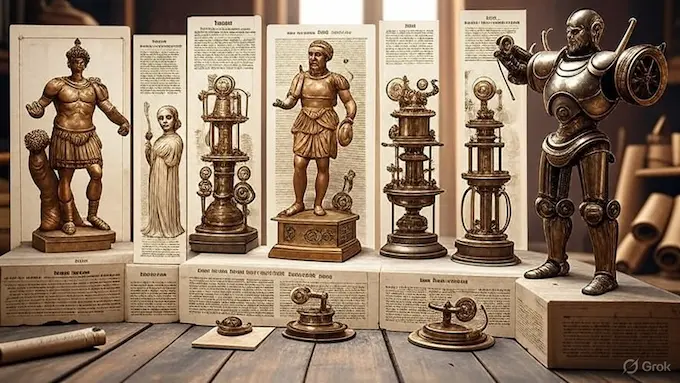
Industrial Age & the Birth of Automation
By the 18th and 19th centuries, engineering had advanced enough to bring mechanical marvels to life not just as myths, but as physical machines.
Automata Entertain the World
Inventors like Jacques de Vaucanson stunned audiences with lifelike automata. His most famous creation was a mechanical duck that could flap its wings, drink water, and mimic digestion. These devices weren’t practical, but they captured the imagination.
The Jacquard Loom: First Programmable Machine
In 1804, Joseph-Marie Jacquard introduced the Jacquard loom, which used punch cards to control weaving patterns. This was a key step toward programmable machines, a direct ancestor of computing and robotics.
Birth of the Word “Robot”
The word “robot” comes from the Czech word robota meaning forced labour or slavery
In 1921, Czech writer Karel Čapek introduced the term robot in his play R.U.R. (Rossum’s Universal Robots). His robots weren’t machines, but artificial workers built to serve humans. The term stuck, and soon became tied to real engineering efforts.
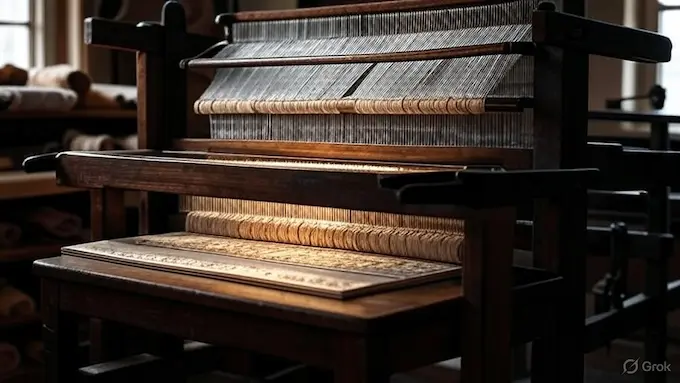
Robotics Becomes Real (20th Century)
The 20th century was when robots left the stage of imagination and entered factories, laboratories, and eventually, homes.
Unimate: The First Industrial Robot
In 1954, George Devol invented the first programmable robotic arm, later commercialized as Unimate. By the 1960s, Unimate was working in General Motors factories, welding and handling hot metal. This marked the start of industrial robotics.
Rise of Cybernetics & Early AI
Researchers in the mid-20th century explored cybernetics (feedback-controlled systems) and early artificial intelligence. Robots like Shakey the Robot (1966) combined sensors and decision-making software, primitive compared to today’s AI, but groundbreaking at the time.
Popular Imagination
Robots also entered popular culture with films like Metropolis (1927), Star Wars (1977), and The Terminator (1984). These depictions influenced public perception and inspired new generations of engineers.
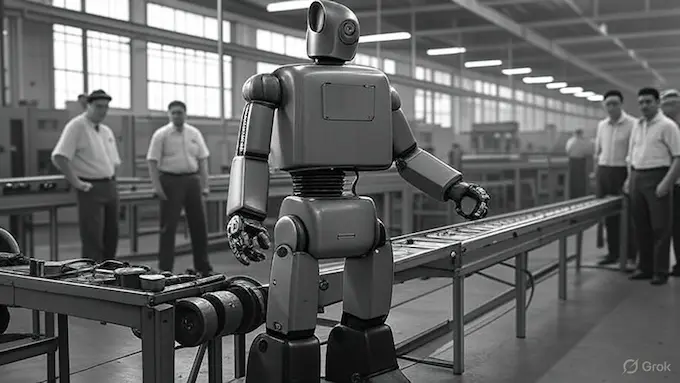
The AI Era of Robotics (1980s–2000s)
By the late 20th century, robotics was merging with artificial intelligence and advanced sensors, giving rise to more sophisticated machines.
Humanoid Robots & Companions
- Honda’s ASIMO (2000): One of the most advanced humanoids, capable of walking, running, and climbing stairs.
- Sony AIBO (1999): A robotic pet dog that introduced robotics into consumer homes.
Space Robotics
- NASA developed robotic arms for the Space Shuttle.
- Mars rovers like Spirit and Opportunity (2004) brought robotics into space exploration.
Smarter Sensing
Advances in computer vision, sensors, and machine learning helped robots navigate environments, recognize objects, and interact with humans.
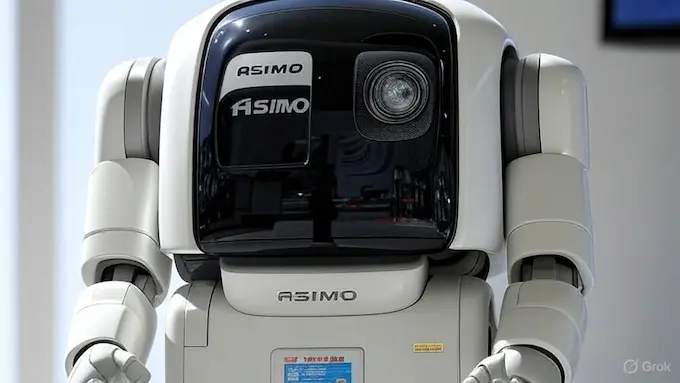
Modern Robotics Revolution (2000s–Present)
The 21st century has seen robotics explode into industries, homes, and society, powered by AI, cloud computing, and massive funding.
Leading Robotics Companies & Inventions
- Tesla Optimus: A humanoid robot designed for repetitive tasks in factories and homes.
- Boston Dynamics: Famous for Spot (robot dog) and Atlas (humanoid) that can run, jump, and perform parkour.
- Agility Robotics: Created Digit, a humanoid designed for warehouses and logistics.
- Unitree Robotics: Affordable quadruped robots for research and industry.
- DJI: The world’s leading drone company, transforming photography, agriculture, and delivery.
- Schunk: Pioneers in robotic grippers and industrial automation.
- Locus Robotics: Warehouse automation solutions using mobile robots.
- Autonomous Vehicles: Companies like Waymo, Tesla, and Nvidia pushing self-driving cars.
AI & Funding Powering Robotics
- Nvidia: Their GPUs and AI platforms (like Jetson) power many of today’s robots.
- Global AI & robotics investment has surged to $30B+ since 2020.
- Robotics market projected to reach $200B+ by 2030.
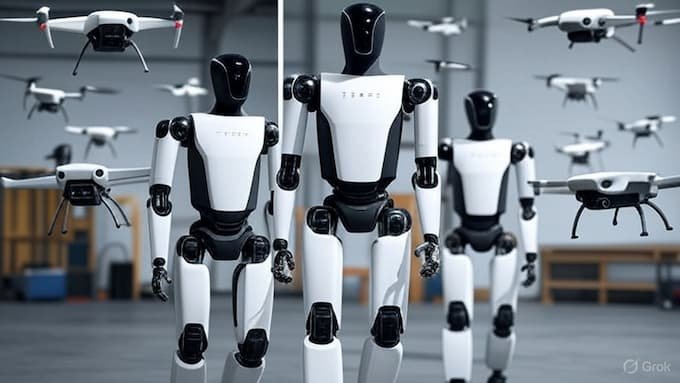
Robotics Expos & Global Innovation Hubs
Robotics progress isn’t just in labs it’s showcased at global expos and conferences.
- CES (Las Vegas): Consumer robots and AI demos.
- Automate Expo (Chicago): Industrial and manufacturing robotics.
- IROS & ICRA: Premier robotics research conferences.
- World Robot Conference (Beijing): Global gathering for robotics innovation.
These expos highlight cutting-edge breakthroughs, from AI-driven humanoids to drone swarms.
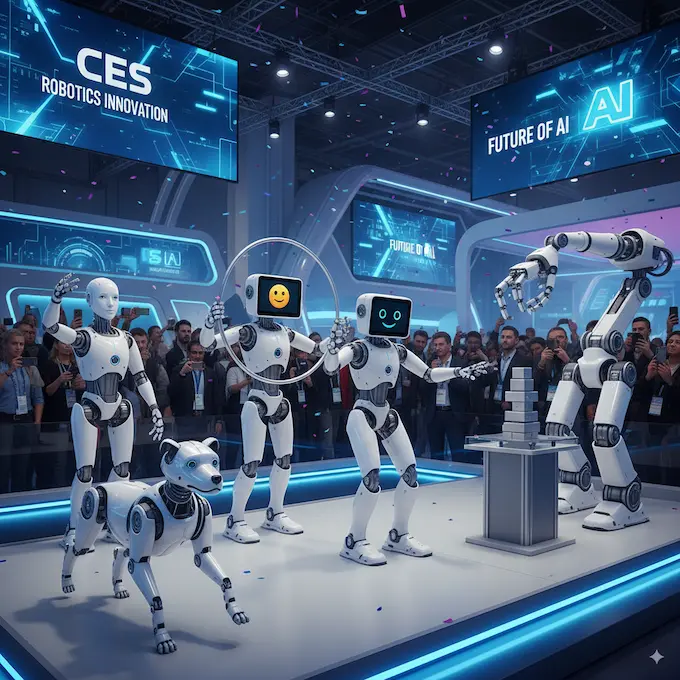
The Future of Robotics (2030 and Beyond)
What comes next for robotics? From history of Robots to Evolution of Robotics The trends suggest a future where robots are everywhere.
Human-Robot Collaboration
Factories, hospitals, and even homes will see humans and robots working side by side.
Swarm & Soft Robotics
- Swarm robotics inspired by ants and bees.
- Soft robotics for delicate tasks (like surgery or food handling).
Ethical Challenges
- Will robots replace jobs?
- Should robots have rights?
- Military use of AI robots, who is accountable?
General-Purpose Robots
The ultimate vision: robots that are not specialized, but versatile, powered by AI as adaptable as the human brain.
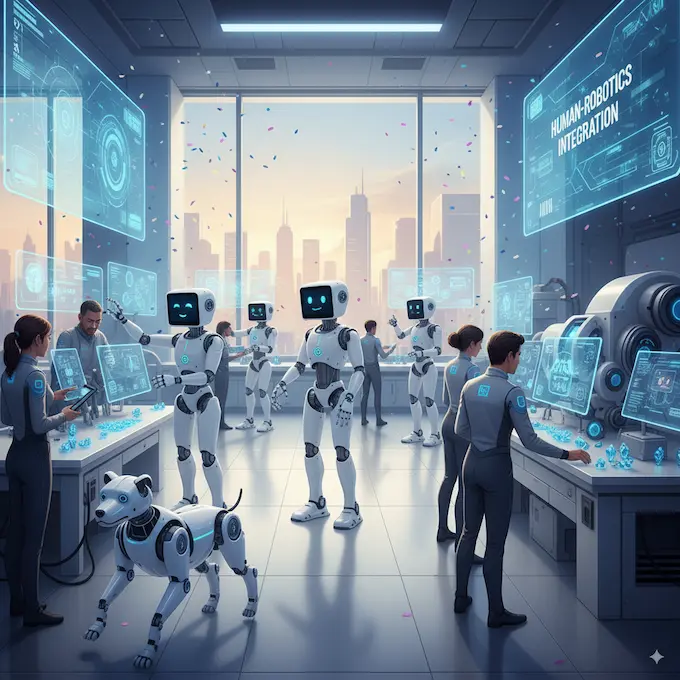
Conclusion
From the myths of Talos in ancient Greece to Tesla’s Optimus and Boston Dynamics’ Atlas, robotics has always been about one thing: the human dream to create life-like machines.
The journey shows us how far we’ve come, from steam-powered automata to AI-driven humanoids that can walk, talk, and even think in limited ways. Today, robotics is not just a niche, it’s shaping industries, economies, and even societies.
As funding grows, expos expand, and companies race toward the future, one thing is certain: the evolution of robotics is just beginning. Stay tuned with Robotics News AI to keep up with the next chapter in this incredible story
Q1: Who invented the first Industrial robot?
The first industrial robot was Unimate, invented by George Devol in 1954.
Q2: Which companies are leading robotics today?
Tesla, Boston Dynamics, Agility Robotics, Unitree, DJI, Schunk, Locus Robotics, and Nvidia in AI hardware.
Q3: How has AI transformed robotics?
AI enables robots to sense, learn, and make decisions, making them more adaptable and intelligent.
Q4: What are the biggest robotics expos?
CES (Las Vegas), Automate Expo, IROS, ICRA, and World Robot Conference in Beijing.
Q5: What will robots look like in 2050?
Experts predict humanoid robots, swarm robots, and AI-driven autonomous machines that blend seamlessly with daily life.
Sources
- Aventine – 13 Milestones in the History of Robotics
- Robotnik – History of Robots and Robotics
- IEEE Spectrum – What Robotics Experts Think of Tesla’s Optimus Robot
- Wikipedia – History of Robots
- Robots Guide – Optimus (Tesla Bot)
- AMT Online – The Evolution of Robotics
- IMTS – History of Robotics: Robotic Generations, Coding, and More
- PMC / NCBI – A History of Robots: From Science Fiction to Surgical Robotics
- Wikipedia – Boston Dynamics
- Wikipedia – Leonardo’s Robot
- Wikipedia – Shakey the Robot
- arXiv – Mapping the Co-Evolution of AI, Robotics, and IoT (1998–2017)
- arXiv – Dissecting Robotics: Historical Overview and Future Perspectives
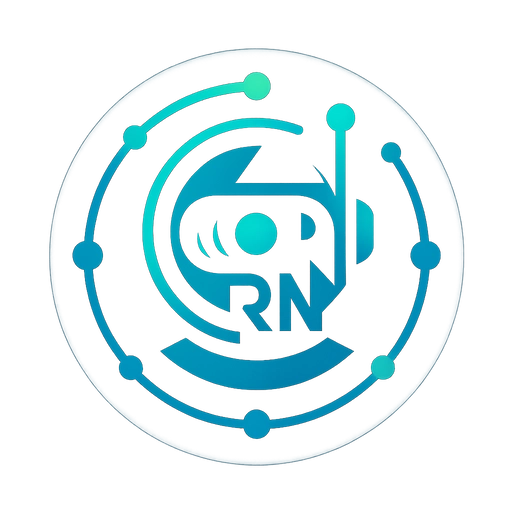


Nice breakdown of robotics evolution.AI is clearly the game changer here.